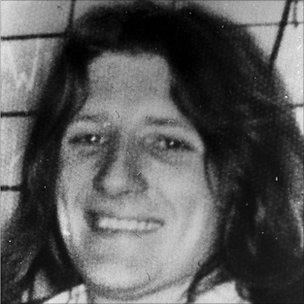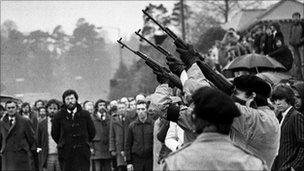Bobby Sands death marked politicisation of republicans
- Published

Bobby Sands died on 5 May 1981
The Banging of bin lids and the shrill sound of whistles announced the death of Bobby Sands on the streets of west Belfast on 5 May 1981.
It was the 66th day of his hunger strike.
The member of parliament for Fermanagh/South Tyrone, who had led IRA prisoners in the Maze prison, had been in a coma for 48 hours.
His physical condition had deteriorated to the point where he had to spend his final days on a water bed to protect his fragile frame.
His death was a seminal moment in the history of the Troubles.
It marked the beginning of a long process of politicisation of republicans.
Until then they had seemed interested only in a physical force answer to the constitutional question.
Bobby Sands was the first of 10 republican prisoners to die in the 1981 hunger strike. It was a period of huge community tension - some 60 civilians, police and soldiers died in the violence which accompanied the seven-month campaign.
Nationalists and republicans were galvanized by the hunger strike.
It was a tactic which struck an emotive historical chord.
Traditional tactic
It had been used by republicans for decades in prison protests - stretching back to the death of Thomas Ashe, a veteran of the 1916 Easter Rising - who had died in jail the following year while being force-fed by the prison authorities.
For unionists, Bobby Sands was a terrorist who was starving himself to death. He had been jailed for possession of a weapon after a fire bomb attack on a Belfast furniture business.
The notion that the British government would grant concessions to such a man was unthinkable.
The hunger strike was part of a wider political struggle between republicans and the government of the day over the legitimacy of the IRA's campaign of violence.
The date it began - 1 March 1981 - had been chosen carefully.
It was the fifth anniversary of the ending of special category or political status for prisoners.
That status had given them the right to wear their own clothes in jail; the right to free association on the wings; the right not to do prison work; the right to education and recreational facilities; and the right to regain any remission of sentence they had lost.

There was a huge turnout at Sands' funeral
Republican hunger strikers wanted to be treated as special category prisoners again. The government, keen to portray the IRA as criminals rather than as a politically motivated, refused.
The IRA leadership was not in favour of a hunger strike. But the prisoners were adamant.
They felt duped after an earlier, failed effort and were determined to proceed. The IRA outside the jail had little choice but to go along with it.
It had been carefully planned. Prisoners were picked from across Northern Ireland to ensure a geographical spread. They started their fasts at intervals to ensure that as one prisoner died, another would be ready to take his place.
It probably would have all played out on the streets and in the jail had it not been for the sudden death of nationalist MP Frank Maguire days into the strike.
The decision to run Bobby Sands as a candidate and the SDLP's agreement not to stand against him, led to a narrow by-election victory, and huge international attention and pressure on the government.
Nationalists assumed the authorities in London would have to cut a deal, because the spectre of an MP dying in jail couldn't be countenanced.
But the Conservative leader, Margaret Thatcher, was adamant she would face down the challenge.
The day after Bobby Sands died she issued a terse statement which set the tone for the rest of the hunger strike.
"Mr Sands was a convicted criminal. He chose to take his own life. It was a choice his organisation did not give to many of their victims," she said.
The funeral was attended by a huge crowd, and the political opportunity afforded by his death quickly became apparent to the republican leadership.
A general election in the Republic the following month, in which two more H-Block prisoners were elected to the Dail (Irish parliament), proved that fighting elections could turn the support for republican prisoners into a political movement with a broad base.
Families
The hunger strike was finally brought to an end when some families took their men off the protest, and the government quietly negotiated a compromise.
But out of it grew the notion of a twin-track republican campaign, IRA violence coupled with Sinn Fein electoral gains.
It was summed up by the party's then communications director Danny Morrison who addressed the 1981 ard fheis.
"Who here really believes we can win the war through the ballot box? But will anyone here object if, with a ballot paper in this hand and an armalite in the other, we take power in Ireland?" he said.
And that was the republican movement set on a path that would ultimately lead to a ceasefire, decommissioning, political agreement and power-sharing.

Violence on the streets accompanied the hunger strikes
That all took another 25 years, and there were many setbacks. But with one eye on their electoral fortunes, republicans could not afford to alienate nationalists for fearing of losing their political support.
That tempered the violent campaign.
Eventually republicans assessed that violence had become counterproductive and decided to lay it aside in favour of a political campaign for unity.
Bobby Sands could not have envisaged Sinn Fein ministers in a power-sharing arrangement at Stormont with the DUP.
Who knows whether he would have approved, or not.
But that was the outworking of the 1981 hunger strike.